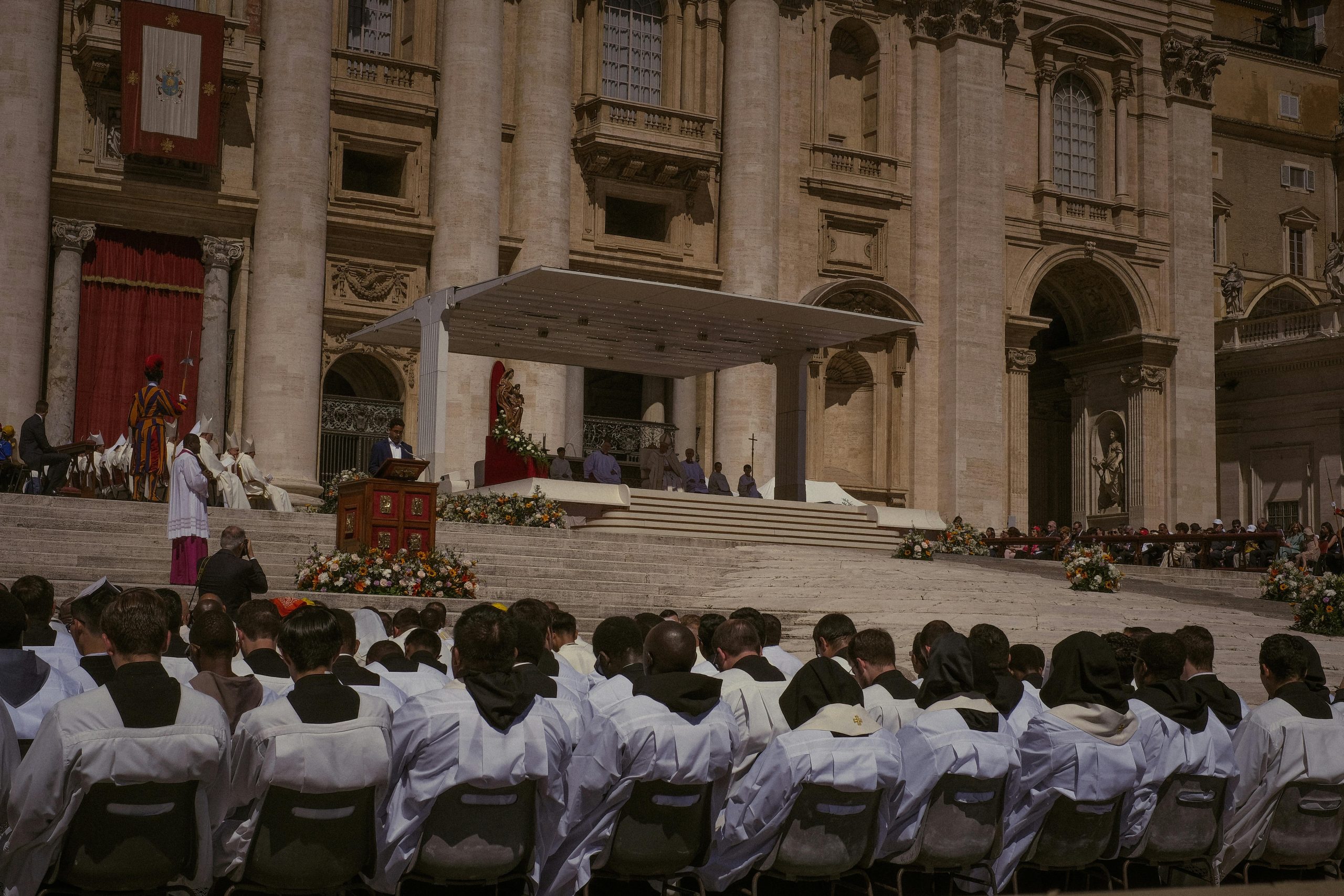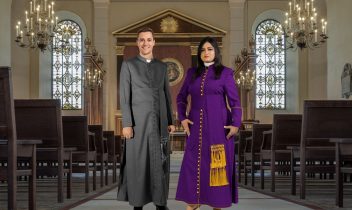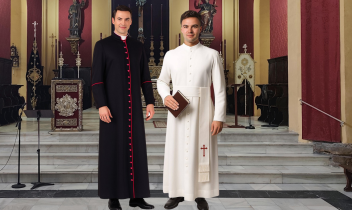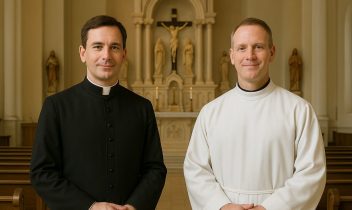No products in the cart.
Return To Shop
The surpliced is one of the most iconic and essential liturgical garments in Christian worship. Worn by clergy, altar servers, and choirs, it has a rich history and continues to hold significance in many Christian denominations today.
Whether you’re unfamiliar with the term or looking for more detailed information on this essential garment, this guide will explore its definition, styles, fabric, and significance in liturgical contexts.
What is a Surplice?
The surplice is a loose, white ecclesiastical garment typically worn over a cassock or alb. It is characterized by its wide sleeves and flowing design, which allows for ease of movement during worship. Historically, the surplice has been worn by clergy during various liturgical events, from Mass to funerals, and continues to be an integral part of many Christian denominations, especially within the Catholic, Anglican, and Lutheran traditions.
Surplice Definition and Meaning
The surplice is derived from the Latin superpellicium, meaning “over the skin,” referring to its role as an outer garment worn over other attire. It’s primarily a liturgical vestment, symbolizing purity and devotion. In modern-day usage, the surplice is seen as a symbol of the priest’s role in the Church, marking the wearer as a servant of God.
The design and usage of the surplice are steeped in tradition, reflecting the ecclesiastical hierarchy and the importance of sacred service. Over time, the surplice evolved to become more than just an outer garment, embodying the spiritual significance of the wearer’s role in worship.
Pronunciation of Surplice
The word “surplice” is pronounced SUR-pli-s (emphasis on the first syllable). For those new to ecclesiastical terminology, this pronunciation can be tricky, but once learned, it becomes an easy term to remember in the context of liturgical attire.
The pronunciation can vary slightly based on regional accents, but the standard form remains consistent in liturgical circles. It is a word that carries significance not only as a garment but as a symbol of faith and devotion.
Surplice Meaning in English
In English, the word surplice refers specifically to a white liturgical garment worn by Christian clergy. It is used in both formal and informal worship settings and is most commonly seen in Catholic, Anglican, and Lutheran traditions. The surplice holds a prominent place in the liturgy, serving as a visual marker of sacred duty and authority.
Its meaning extends beyond just the garment it is deeply connected to the act of worship itself. The surplice, as worn by clergy, represents the purity and sanctity of the office and the service rendered to the Church.
Surplice Styles and Patterns
The surplice is available in various designs, each reflecting the liturgical needs of the occasion and the traditions of the specific Christian denomination.
Surplice Design
Surplices are available in many designs, ranging from simple and plain to more elaborate, lace-trimmed styles. The design often reflects the specific religious tradition and purpose of the garment. Some surplices feature intricate embroidery, often with symbols of the faith or designs representing the liturgical season.
Design elements such as lace, embroidery, and special patterns can significantly enhance the garment’s appearance, making it not just a functional piece of clothing but also a work of art. The choice of design often aligns with the theme of the liturgical season, ensuring that the garment serves its intended purpose both practically and symbolically.
For example, during Lent, surplices may feature more understated designs, while for celebrations like Christmas or Easter, they may include more ornate features such as gold thread or intricate lace.
Lace Surplice Catholic
A lace surplice is a highly decorated variation of the surplice, often worn by Catholic clergy or choirs during special liturgical celebrations. The lace adds elegance and sophistication, making it particularly suitable for events like weddings, feast days, or high holy days. The lace symbolizes beauty and grace, complementing the sacred act of worship.
Catholic clergy may wear lace surplices during more solemn and festive occasions, where the visual impact is important in conveying the majesty of the occasion. The lace often features intricate patterns, including floral motifs or religious symbols, which help elevate the overall aesthetic of the service.
In addition, the lace surplice helps create a sense of separation between the sacred and the ordinary. Its ornate nature serves as a visual reminder of the heavenly realm during worship.
Surplice Fabric
The fabric used to make surplices varies depending on the season and the formality of the service. Common fabrics include lightweight cotton, linen, and blends. These fabrics ensure the wearer remains comfortable while performing liturgical duties. The material choice also plays a role in the garment’s durability and overall appearance.
For more formal occasions, silks and satin-like fabrics are sometimes used, offering a polished, luxurious appearance. During warmer seasons, breathable fabrics like cotton and linen are preferred for their cooling properties.
In colder climates, a choice of thicker fabrics like wool or wool blends may be used, ensuring warmth while maintaining the aesthetic of the garment. The texture and weight of the fabric also contribute to the garment’s flow and movement, which is important for its use in liturgical settings.
Types of Surplices
Surplices come in different styles, each serving a specific purpose or fitting a particular liturgical tradition.
Different Types of Surplices
Surplices can range from full-length garments that reach the feet to shorter styles often worn by altar servers. Full-length surplices are generally reserved for clergy, while shorter versions are more common among altar servers. The exact design can also vary based on the tradition of the Church and the occasion.
A full-length surplice typically has a more formal appearance and is worn during significant liturgical events, while a shorter surplice is more practical and comfortable for frequent use by altar servers or in less formal settings. The full-length surplice is also more likely to feature intricate details, while the shorter version is often simpler and more utilitarian.
Surplice Style and Ecclesiastical Traditions
The surplice style can vary across ecclesiastical traditions. In Catholic and Anglican practices, for example, surplices tend to be more ornate, sometimes with lace or embroidered details. In contrast, Lutheran surplices might be simpler and more utilitarian in design. Regardless of the specific style, the surpliced serves as a symbol of the clergy’s office and role within the Church.
The overall design often reflects the theology and liturgical practice of the denomination. Catholic and Anglican traditions may incorporate more elaborate designs, with lace and embroidery representing the beauty of divine worship. In contrast, the Lutheran tradition might focus more on the simplicity and humility of service, with plainer surplices being preferred.
Surplice and Other Garments
The surpliced is often paired with other liturgical garments. Its relationship with these items helps define the role of the clergy in worship and signifies various theological and symbolic meanings.
Surplice and Cotta
The cotta is a shorter version of the surpliced, often worn over a cassock. While both garments are similar in design, the cotta tends to be less elaborate, and its use is typically restricted to less formal occasions. Clergy may choose a cotta for daily services, while the full-length surplice is preferred for more formal liturgies.
The cotta is typically worn by deacons, seminarians, and altar servers in many liturgical settings. It’s a versatile garment that provides an easy-to-wear option for those who do not require the full ceremonial attire but still want to maintain the appearance of reverence and professionalism.
Rochet and Surplice
The rochet is another liturgical garment worn by clergy, typically higher-ranking officials like bishops. While the surplice is usually a simple, white garment, the rochet is often more formal and has a structured cut. It is frequently worn with a stole or chasuble during important liturgical services, reflecting the wearer’s rank and authority within the Church.
The rochet has a slightly different style compared to the surpliced, often being longer and more fitted. It is worn with other vestments, such as the chasuble, to signify the hierarchical nature of the clergy.
Alb and Surplice
The alb is a full-length garment worn by clergy and altar servers. It serves as the foundational garment beneath the surplice. The alb is typically white and symbolizes purity. In contrast, the surplice is often worn as an overgarment, completing the liturgical attire. Together, the alb and surplice represent both humility and devotion in the Christian faith.
The alb is usually worn as the base layer in the liturgical attire, with the surplice worn on top to symbolize the sacred nature of the ceremony. In some Christian denominations, the alb alone may suffice for less formal services, but the surplice is often worn for more formal occasions or when the liturgy requires a more distinctive appearance.
Surplice and Stole
The stole is a long, narrow garment worn by clergy around the neck, often over the surplice. The stole represents the authority of the priest or deacon and is typically worn during Sacraments, including the Eucharist and Baptism.
The stole is a distinctive element of the clerical vestment, symbolizing the priestly office and the power of the sacraments. When worn over the surplice, it adds a sense of authority and purpose to the attire, marking the clergy as representatives of Christ in the service of the Church.
Conclusion
The surpliced is an essential part of Christian liturgical attire, symbolizing the sacred duty of the clergy and their role in serving God and the congregation. Its history, design, and symbolic significance continue to influence modern worship practices, making it a garment that transcends time and tradition.
Whether you’re a priest, choir member, or altar server, the surpliced serves as a reminder of the divine calling of those who wear it. Its elegant simplicity and timeless design continue to make it a staple of Christian liturgical life.
Whether you’re a priest, choir member, or altar server, the surplice symbolizes a divine calling. Find timeless designs at Holy Clergy.
Frequently Asked Questions (FAQs)
What is the surplice used for?
The surplice is worn by clergy, altar servers, and choirs during Christian worship services. It is a symbol of purity, humility, and devotion, serving as an outer garment over other liturgical attire.
What is the difference between a surplice and a cotta?
The surplice is a full-length garment, while the cotta is shorter and less elaborate. The surplice is worn during more formal occasions, while the cotta is often used for daily services.
Can a surplice be worn without a cassock?
Typically, a surplice is worn over a cassock or alb. It is an overgarment that completes the liturgical attire, providing a polished and appropriate appearance for worship.
Is the surplice worn in all Christian denominations?
The surpliced is primarily used in Catholic, Anglican, and Lutheran traditions, although variations exist depending on the denomination and local customs.
What does a surpliced symbolize?
The surpliced symbolizes purity, service, and devotion to God. It reflects the sacred duties of the clergy and serves as a visual marker of the wearer’s role in the Church.
Why is it called a surplice?
The term “surplice” comes from the Latin word superpelliceum, which means “worn over the skin.” This reflects the garment’s design to be worn over other clothing, such as a cassock or alb, during liturgical services.








Recent Comments